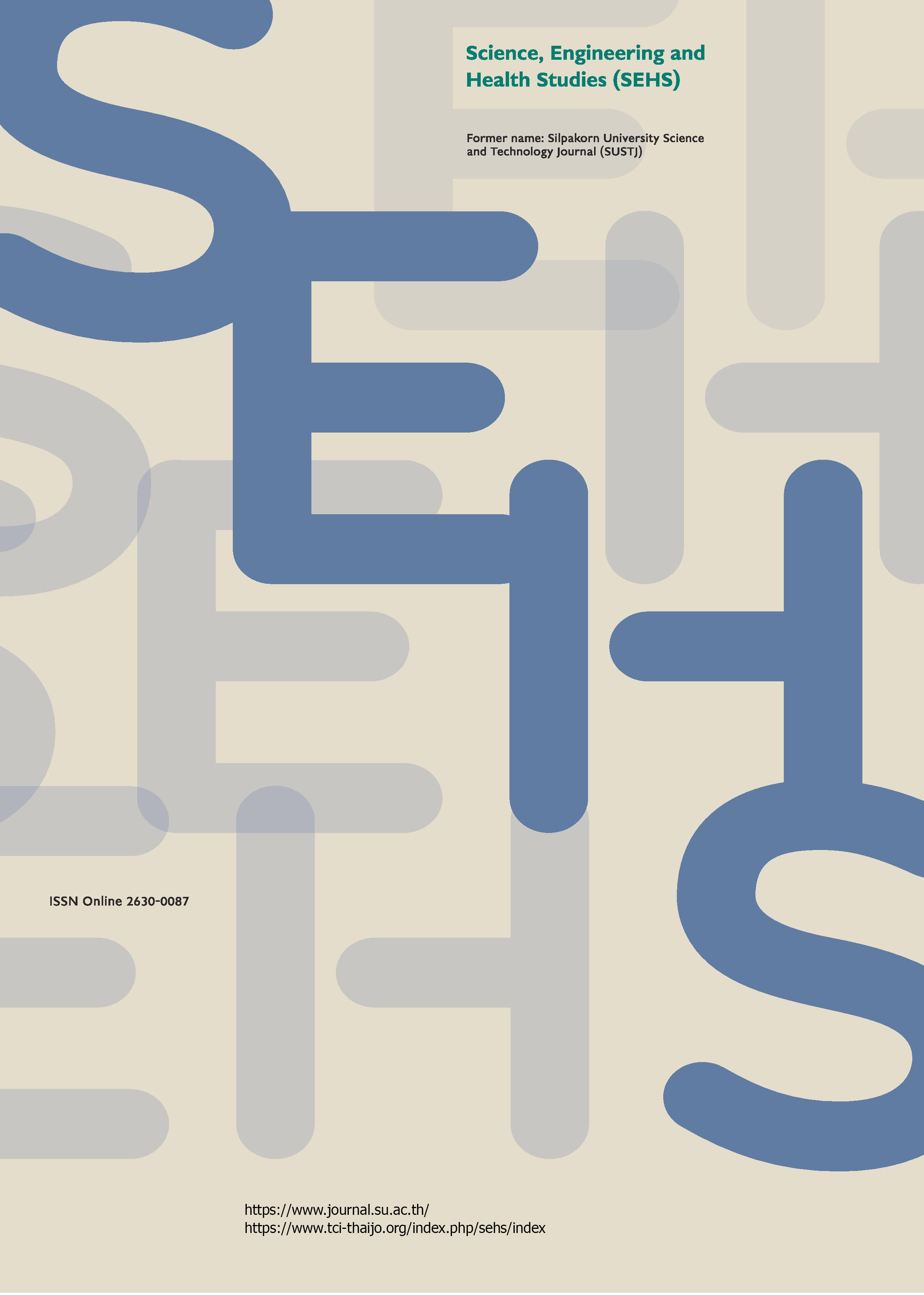Formulation and stability of Prasaplai microemulsions
Main Article Content
Abstract
Prasaplai is a Thai herbal remedy used in obstetrics and gynecology. In this study, Prasaplai microemulsions (MEs) were developed for topical use, using two types of oil: isopropyl myristate (IPM) and tea tree oil, with polysorbate 80 and butanol as the surfactant and co-surfactant, respectively. The stability of Prasaplai MEs under accelerated conditions was studied. Prasaplai MEs from both oil types had a clear yellow color, with a diameter between 236 and 257 nm. The pH values of all ME were between 5.14 and 5.45, and the viscosities were between 19 and 26 centipoises, with Newtonian flow behavior. After storage under accelerated conditions, the tea tree oil-based MEs showed phase separation, whereas the IPM-based MEs were homogeneous. The size of the tea tree oil-based MEs increased, while pH decreased after storage. The decrease in pH indicated the presence of degradation products in the formulations. The IPM-based Prasaplai MEs reduced in size, and the pH value increased. The amount of remaining curcumin was 73.80% in the tea tree oil-based MEs and 92.20 % in the IPM-based MEs. In conclusion, oil types and ingredients in Prasaplai affects the stability of the MEs. IPM-based Prasaplai MEs might be better for use as topically applied remedies.
Downloads
Article Details
References
Acharya, D. P., and Hartley, P. G. (2012). Progress in microemulsion characterization. Current Opinion in Colloid & Interface Science, 17(5), 274-280.
Asia Pacific Petrochemical (2018). n-Butanol. [Online URL: http://www.apcbkk.com/pdf/products/Alcohols/SDS/n-_TH.pdf] accessed on February 23, 2019.
Azeem, A., Khan, Z. I., Aqil, M., Ahmad, F. J., Khar, R. K., and Talegaonkar, S. (2009). Microemulsion as a surrogate carrier for dermal drug delivery. Drug Development and Industrial Pharmacy, 35(5), 525-547.
Bergonzi, M. C., Hamdouch, R., Mazzacuva, F., Isacchi, B., and Bilia, A. R. (2014). Optimization, characterization and in vitro evaluation of curcumin microemulsions. LWT-Food Science and Technology, 59(1), 148-155.
Calligaris, S., Valoppi, F., Barba, L., Pizzale, L., Anese, M., Conte, L., and Nicoli, M. C. (2017). Development of transparent curcumin loaded microemulsions by phase inversion temperature (PIT) method: effect of lipid type and physical state on curcumin stability. Food Biophysics, 12, 45-51.
Carson, C. F., Hammer, K. A., and Riley, T. V. (2006). Melaleuca alternifolia (tea tree) oil: a review of antimicrobial and other medicinal properties. Clinical Microbiology Reviews, 19(1), 50-62.
Fratter, A., and Semenzato, A. (2011). New association of surfactants for the production of food and cosmetic nanoemulsions: preliminary development and characterization. International Journal of Cosmetic Science, 33(5), 443-449.
Iskandarsyah, H., and Rahman, A. (2018). Accelerated stability testing of anti-aging cream: formation of myristic acid and stearic acid as degradation products. International Journal of Apply Pharmaceutics, 11(1), 1-5.
Kharat, M., Du, Z., Zhang, G., and McClements, D. J. (2017). Physical and chemical stability of curcumin in aqueous solutions and emulsions: impact of pH, temperature and molecular environment. Journal of Agricultural and Food Chemistry, 65(8), 1525-1532.
Kharat, M., Zhang, G., and McClements, D. J. (2018) Stability of curcumin in oil-in-water emulsions: impact of emulsifier type and concentration on chemical degradation. Food Research International, 111, 178-186.
Kishore, R. S. K., Pappenberger, A., Dauphin, I. B., Ross, A., Buergi, B., Staempfli, A., and Mahle, H. (2011). Degradation of polysorbates 20 and 80: studies on thermal autoxidation and hydrolysis. Journal of Pharmaceutical Sciences, 100(2), 721-731.
Kumar, A., Kushwaha, V., and Sharma, P. K. (2014). Pharmaceutical microemulsion: formulation, characterization and drug deliveries across skin. International Journal of Drug Delivery and Research, 6(1), 1-21.
Mondal, S., Ghosh, S., and Moulik, S. P. (2016). Stability of curcumin in different solvent and solution media: UV-visible and steady-state fluorescence spectral study. Journal of Photochemistry and Photobiology, B: Biology, 158, 212-218.
National Drug Information [Online URL:http://ndi.fda.moph.go.th/drug_national_detail/index/22/herb] accessed on May 17, 2020.
Pakpayat, N., Yotsawimonwat, S., and Boonme, P. (2011) Green Microemulsions for Cosmetics. Thai Pharmaceutical and Health Science Journal, 6(4), 290-298. (in Thai)
Pubchem. (2020). Isopropyl myristate. National Center of Medicine. [Online URL: https://pubchem.ncbi.nlm.nih.gov/compound/Isopropyl-myristate] accessed on May 20, 2020.
Roohpour, N., Wasikiewicz, J. M., Moshaverinia, A., Paul, D., Rehman, I. U., and Vadgama, P. (2009). Isopropyl Myristate-Modified Polyether-Urethane Coatings as Protective Barriers for Implantable Medical Devices. Materials, 2(3), 719-733.
Rustan, A. C., and Devon, C. A. (2005). Fatty acid structure and properties. Encyclopedia of Life Science. [Online URL:https://www.researchgate.net/publication/227992501_Fatty_Acids_Structures_and_Properties] accessed on May 25, 2020.
Shen, L., and Ji, H. (2012). The pharmacology of curcumin: is it the degradation products? Trends in Molecular Medicine, 18(3), 138-144.
Sriyakul, K., Kietinun, S., Pattaraarchachai, J., and Ruangrungsi, N. (2012). A comparative double-blinded randomized study: the efficacy of Prasaplai herbal extract versus mefenamic acid in relieving pain among primary dysmenorrhea patients. The Open Complementary Medicine Journal, 4, 16-21.
Tangyuenyongwatana, P., and Grisanapan, W. (2016). Standardization of Prasaplai, a Thai traditional preparation for antidysmenorrhea. Botanics: Targets and Therapy, 6. [Online URL: https://www.dovepress.com/standardization-of-prasaplai-a-thai-traditional-preparation-for-antidy-peer-reviewed-article-BTAT] accessed on May 20, 2020.
Temsiririrkkul, R. (2016) Prasaplai and menstrual pain. [Online URL:https://pharmacy.mahidol.ac.th/en/knowledge/article/346/] accessed on September 24, 2019.
Thakkar, H. P., Patel, A. A., and Chauhan, N. P. (2014). Formulation and optimization of mucoadhesive microemulsion containing mirtazapine for intranasal delivery. Chronicles of Young Scientists, 5(1), 25-32.
Valenta, C., and Shultz, K. (2004). Influence of carrageenan on the rheology and skin permeation of microemulsion formulations. Journal of Control Release, 95(2), 257-265.
Wisai, M., Sripong, P., Nualkaew, S., and Sawangjit, R. (2019). Pilot study on efficacy and safety of Prasaplai extract capsules for relieving acute pain from muscle strain. Thai Journal of Pharmacy Practice, 11(1), 269-283. (in Thai).


